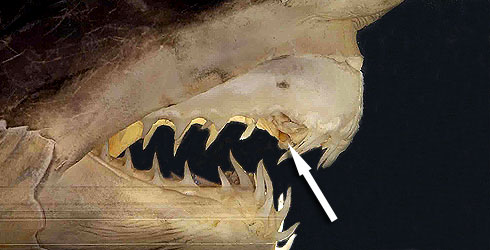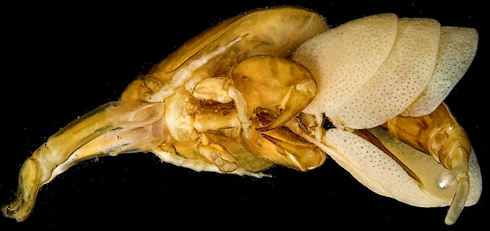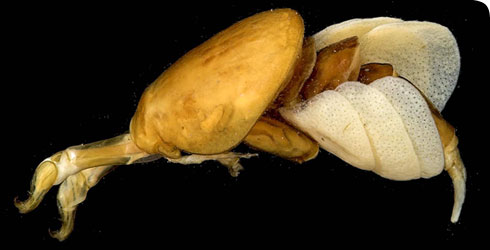Anthosoma crassum
Anthosoma crassum is a copepod crustacean and a parasite of fish, particularly sharks.
The preferred hosts are fast swimming lamniform sharks, including
- blue shark
- mako shark
- white shark
but it has also been reported from the whale shark and from a bony fish, ocean sunfish (Kabata).
Once on its host Anthosoma crassum burrows into the skin until it is partially buried, with only its rear end protruding from the cavity it has excavated.
Shark skin is tough and the copepods often burrow into softer tissues such as the mouth, or walls of the gill chamber.
Anthosoma crassum feeds on the tissues and blood of its hosts.
Species detail
Anthosoma crassum attaches to the host by means of long clawed antennae.
The antennae are then
- withdrawn into sheaths that extend back into the head of the parasite
- the parasite is brought into closer more secure contact with the host
Anthosoma crassum then uses its strongly clawed maxillipeds to pull itself into position, so the tubular mouth comes into direct contact with the skin of its host.The crustacean then rasps away at the skin using its toothed mandibles which lie within the tubular mouth.
-

Attachment and feeding
Learn how Anthosoma crassum attaches itself to and feeds from its host and see a photo demonstrating the attachment of the species to its host.
-

Morphology
Find out about the form and structure of Anthosoma crassum with a breakdown by male and female.
-

Distribution
Discover the oceans in which Anthosoma crassum can be found as well as the preferred host that it parasitises.
-

Lifecycle
Anthosoma crassum depends on its host in order to complete its lifecycle. Read about the various stages of development during the lifecycle of this species.
-

References
Get reference material for Anthosoma crassum.
Images

Anthosoma crassum a copepod crustacean and a parasite of fish, particularly sharks.
© G Boxshall
The rear end of an adult (arrowed) Anthosoma crassum is visible embedded in the roof of the mouth, between the teeth, in this mako shark caught off St Helena.

A close up of the limbs found on the head of Anthosoma crassum
© G Boxshall
Anthosoma crassum showing the limbs on the head.
© G BoxshallAbout the author

Prof Geoff Boxshall
Merit Researcher in the Crustacea Research Group, focusing on patterns of diversity in copepods and the biology of parasitic copepods from fish and marine invertebrate hosts.
